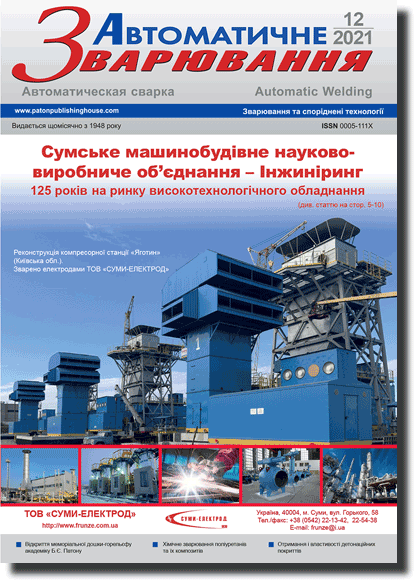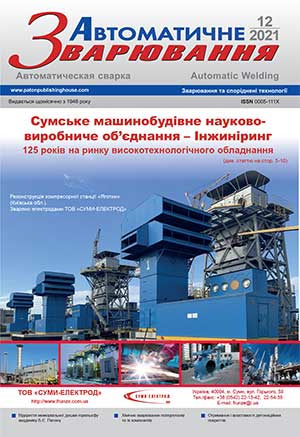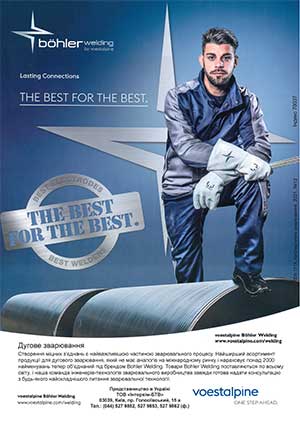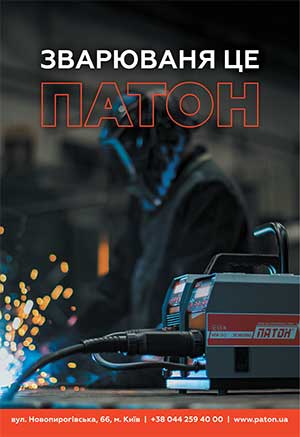| 2021 №12 (01) |
DOI of Article 10.37434/as2021.12.02 |
2021 №12 (03) |

"Avtomatychne Zvaryuvannya" (Automatic Welding), #12, 2021, pp. 18-26
Features of laser-plasma welding of corrosion-resistant steel aisi 304 using laser
V.M. Korzhyk1, V.Yu. Khaskin1, A.A. Grynyuk2, E.V. Illyashenko2, A.V. Bernastkyi2, S.I. Peleshenko3
1China-Ukraine E.O. Paton Institute of Welding of the Guangdong Academy of Sciences. Guandong Key Laboratory of Advanced Welding Technologies, Guangzhou, China
2E.O. Paton Electric Welding Institute of the NAS of Ukraine. 11 Kazymyr Malevych Str., 03150, Kyiv, Ukraine. E-mail: offi ce@paton.kiev.ua
3NTUU «Igor Sikorsky Kyiv Polytechnic Institute» 37 Peremohy Ave., Kyiv
The paper confi rms the presence of synergic eff ect at laser-plasma welding, using fi ber laser, by comparing the cross-sectional areas of beads deposited in AISI 304 plate (δ = 4 мм) by laser, plasma, and hybrid processes at close power values of laser radiation and plasma arc (~2 kW each). It is determined that the manifestation of this eff ect depends on welding speed. At the speed of 2 m/min the hybrid bead cross-sectional area can exceed the sum of areas produced with the laser and plasma processes by up to 30%, and for the speed of 4 m/min by ~20 %. Comparison of input energy of the laser and hybrid processes of stainless steel welding showed that the diff erence between them depends on the welded sheet thickness (or penetration depth). This value fi rst decreases from ~100 % for sheets with δ = 2 mm to 50 % for sheets with δ = 6 mm, and at further increase of penetration depth it rises to 60 %. The nature of dependencies of the factor of area ratio φ, weld geometry К and penetration depth Ф on the speed of hybrid welding of AISI 304 steel allows recommending the range of speeds of 1.5…2.0 m/min, as a more acceptable by the criteria of synergic eff ect and penetration depth. It is found that at hybrid welding with application of fi ber laser radiation, the plasma component promotes elimination of such defects of weld upper bead formation, characteristic for laser welding, as undercuts and a ridge, etc. 19 Ref., 2 Tabl., 10 Fig.
Keywords: hybrid laser-plasma welding, fi ber laser, stainless steel, synergic eff ect, penetration depth, energy input
Received: 18.10.2021
References
1. Khaskin, V.Yu., Korzhyk, V.M., Bernatskii, A.V. et al. (2020) Features of synergistic effect manifestation in laser-plasma welding of SUS304 steel, using disc laser radiation. The Paton Welding J., 4, 29-33. https://doi.org/10.37434/as2020.04.042. Thomy, C., Seefeld, T. (2006) Basics and applications of laser-GMA hybrid welding. Ibid, 6, 28-32.
3. Simões, L.M.C. (2010) Design, fabrication and economy of welded structures. Structural and Multidisciplinary Optimization, 40(1), 629-629. https://doi.org/10.1007/s00158-008-0356-y
4. Kah, P., Salminen, A., Martikainen, J. (2010) Laser-ARC hybrid welding processes (Review). The Paton Welding J., 6, 32-40.
5. Hu, B., Ouden, G. den. (2005) Laser induced stabilisation of the welding arc. Science and Technology of Welding and Joining, 10, 1, 76-81.7 https://doi.org/10.1179/174329305X29537
6. Seyffarth, P., Krivtsun, I. (2002) Laser-Arc Processes and Their Applications in Welding and Material Treatment. London, Taylor and Francis Books, 1. https://doi.org/10.1201/9781482264821
7. (2018) Physical processes in welding and processing of materials. Theoretical study, mathematical modeling, computational experiment. In: Transact. of NANU. Ed. by V.I. Krivtsun. Kiev, IAW [in Russian].
8. Eriksson, I., Powell, J., Kaplan, A. (2013) Guidelines in the choice of parameters for hybrid laser arc welding with fiber lasers. Physics Procedia, 41, 119-127. https://doi.org/10.1016/j.phpro.2013.03.059
9. Reisgen, U., Krivtsun, I., Gerhards, В., Zabirov, A. (2016) Experimental research of hybrid welding processes in combination of gas tungsten arc with CO2- or Yb:YAGlaser beam. Journal of Laser Applications, 28, 022402. https://doi.org/10.2351/1.4944096
10. Wetzig, A., Herwig, P., Hauptmann, J. et al. (2016) Latest developments of laser cutting. Journal of Laser Applications, ICALEO 2016, 103. https://doi.org/10.2351/1.5119063
11. Jokinen, T., Vihervä, T., Riikonen, H. (2000) Welding of ship structural steel A36 using a Nd:YAG laser and gas-metal arc welding. Journal of Laser Applications, 12, 185-189. https://doi.org/10.2351/1.1309549
12. Sokolov, М., Salminen, А. (2014) Improving Laser Beam Welding Efficiency. Physics Procedia, 6(09), 559-571 https://doi.org/10.4236/eng.2014.69057
13. Sokolov, М., Salminen, А., Somonov, V., Kaplan, A.F.H. (2012) Laser welding of structural steels: Influence of the edge roughness level. Optics & Laser Technology, 44, 7, 2064-2071. https://doi.org/10.1016/j.optlastec.2012.03.025
14. DuPont, J.N., Marder, A.R. (1995) Thermal Efficiency of Arc Welding Processes. Welding J., 74, 12, 406-416.
15. Hipp, D., Mahrle, A., Beyer, E. et al. (2019) Thermal Effi ciency Analysis for Laser-Assisted Plasma Arc Welding of AISI 304 Stainless Steel. Materials (Basel), 12(9):1460, 1-14. https://doi.org/10.3390/ma12091460
16. Khaskin, V.Yu., Korzhik, V.N., Chizhskaya, T.G. et al. (2016) Eff ect of laser radiation absorption on effi ciency of laser welding of copper and its alloys. The Paton Welding J., 11, 31-35. https://doi.org/10.15407/tpwj2016.11.05
17. Krivtsun, I.V., Shelyagin, V.D., Khaskin, V.Yu. et al. (2007) Hybrid laser-plasma welding of aluminium alloys. Ibid, 5, 36-40.
18. Fuerschbach, P.W., Eisler, G.R. (2002) Eff ect of laser spot weld energy and duration on melting and absorption. Science and Technology of Welding and Joining, 7, 241-246. https://doi.org/10.1179/136217102225004293
19. Fuerschbach, P.W. (1996) Measurement and Prediction of Energy Transfer Effi ciency in Laser Beam Welding. Welding J., 75, 24-34. DOI: https://doi.org/AC04-94AL85000
Advertising in this issue:
The cost of subscription/purchase order journals or individual articles
| Journal/Currency | Annual Set | 1 issue printed |
1 issue |
one article |
| TPWJ/USD | 384 $ | 32 $ | 26 $ | 13 $ |
| TPWJ/EUR | 348 € | 29 € | 24 € | 12 € |
| TPWJ/UAH | 7200 UAH | 600 UAH | 600 UAH | 280 UAH |
| AS/UAH | 1800 UAH | 300 UAH | 300 UAH | 150 UAH |
| AS/USD | 192 $ | 32 $ | 26 $ | 13 $ |
| AS/EUR | 180 € | 30 € | 25 € | 12 € |
| SEM/UAH | 1200 UAH | 300 UAH | 300 UAH | 150 UAH |
| SEM/USD | 128 $ | 32 $ | 26 $ | 13 $ |
| SEM/EUR | 120 € | 30 € | 25 € | 12 € |
| TDNK/UAH | 1200 UAH | 300 UAH | 300 UAH | 150 UAH |
| TDNK/USD | 128 $ | 32 $ | 26 $ | 13 $ |
| TDNK/EUR | 120 € | 30 € | 25 € | 15 € |
AS = «Automatic Welding» - 6 issues per year;
TPWJ = «PATON WELDING JOURNAL» - 12 issues per year;
SEM = «Electrometallurgy Today» - 4 issues per year;
TDNK = «Technical Diagnostics and Non-Destructive Testing» - 4 issues per year.









